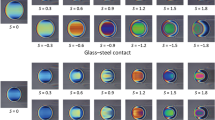The investigations deal with the study of the heat-shielding effect of thin oil films during the passage of heat flux through them, the conditions for its occurrence, and the space-time region of propagation through heterogeneous media with account for the reduced thermophysical characteristics. The paper presents theoretical calculations and experimental investigations conducted on a special self-engineered device. Consideration has been given to the influence of the oil film thickness, the amplitude and time of the heat pulse on the velocity of its propagation simultaneously through a lubricated contact and an unlubricated one. The results of observations over the pattern of heat flux propagation has made it possible to draw a conclusion that the heat flux released, for example, as a result of friction on a microscopic contact is characterized by high density and propagates with a significant velocity predominantly in the direction with the least thermal resistance determined by the thermophysical characteristics and the temperature potential of the material. Considering that the processes occur at the microscopic level, such materials include thin boundary films (oil. oxide, spray-applied and other films) with a thickness comparable with the height of microroughnesses.
Similar content being viewed by others
References
I. V. Kragel’skii, Friction and Wear [in Russian], Mashinostroenie, Moscow (1968).
A. Begelinger and A. W. Y. de Gee, Lubrication of sliding point contacts of AISI 52100 steel — The influence of curvature, Wear, 36, No. 1, 7−11 (1976).
D. Berry and D. Barber, Distribution of heat released in friction: A way to study the nature of contact phenomena in sliding, Probl. Friction, No. 3, 83–96 (1984).
V. A. Shevchuk, Analytical solution of nonstationary heat conduction problem for a half-space with a multilayer coating, J. Eng. Phys. Thermophys., 86, No. 2, 450–454 (2013).
V. A. Shevchuk and A. P. Gavris’, Nonstationary heat-conduction problem for a half-space with a multilayer coating upon cyclic change in the ambient temperature, J. Eng. Phys. Thermophys., 93, No. 6, 1489–1497 (2020).
I. A. Buyanovskii, Temperature-kinetic method of evaluating temperature limits of serviceability of lubricating materials in the thermal regimes of boundary lubrication, Friction Wear, 14, No. 1, 129–142 (1993).
V. A. Balakin and Yu. V. Lysenok, Heat release and heat transfer in the friction contact zone, Vestn. Gomelsk. Gos. Tekh. Univ., No. 1, 3–7 (2001).
N. S. Belyakov and A. P. Nosko, Mathematical modeling of nonideal thermal contact of friction bodies, Teplofiz. Vys. Temp., 27, No. 1, 129–136 (2009).
N. V. Polyakov, D. A. Popov, and E. V. Snyatkov, Towards the calculation of thermal loading of the friction contact in intermittent retardations, Orel GTU. Mir Transp. Tekhnol. Mashin, 36, No. 1, 31–35 (2012).
A. I. Serebryanskii, V. V. Abramov, and D. A. Kanishchev, Methods and results of investigations into friction temperature in the swivel joints of timber loaders, Forestry Eng. J., 4, No. 1, 189–194 (2014).
A. V. Chichinadze, É. M. Berliner, and É. D. Brown, Friction, Wear, and Lubrication (Tribology and Triboengineering) [in Russian], Mashinostroenie, Moscow (2003).
M. Khembdy and A. V. Chichinadze, Handbook on Triboengineering [in Russian], Vol. 1, Mashinostroenie, Moscow (1992).
A. V. Chichinadze, Tribological thermal regime in gears, Mashinostroitel′, No. 10, 3–46 (2000).
D. A. Popov, A. M. Kadyrmetov, and A. S. Pustovalov, Device for investigation of the heat-shielding effect of boundary oil films, Proc. Conf. on the Results of the Int. Tech. Conf. "Mekhtribotrans–2016," Rostov State Transport University, Rostov-on-Don, Vol. 1, pp. 223–227 (2016).
D. A. Popov, A. M. Kadyrmetov, V. V. Zaikin, and A. Yu. Sinel′nikov, Analytical calculation of temperature on a friction surface with account for the shielding effect of thin boundary films, in: Areas of Current Importance in the Scientific Investigations of the 21st Century: Theory and Practice. Collection of Research Papers Based on Proc. Int. Virtual Research and Practice Conference, Voronezh (2016), Vol. 4, No. 5, Pt. 4, pp. 115–120.
A. A. Spiridonov, Planning an Experiment in Investigating Technological Processes [in Russian], Mashinostroenie, Moscow (1981).
Author information
Authors and Affiliations
Corresponding author
Additional information
Translated from Inzhenerno-Fizicheskii Zhurnal, Vol. 94, No. 6, pp. 1489–1500, November–December, 2021.
Rights and permissions
About this article
Cite this article
Popov, D.A., Kadyrmetov, A.M. & Pustovalov, A.S. Space-Time Region of Propagation of Heat Flux Through a Lubricated Contact with Account for the Heat-Shielding Effect of Oil Films. J Eng Phys Thermophy 94, 1456–1466 (2021). https://doi.org/10.1007/s10891-021-02425-3
Received:
Published:
Issue Date:
DOI: https://doi.org/10.1007/s10891-021-02425-3




